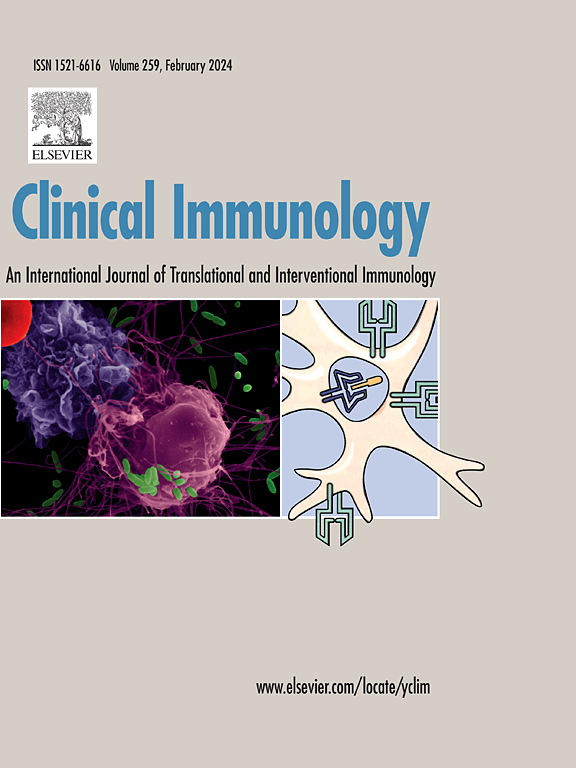系统性红斑狼疮患者感染风险与低丙种球蛋白血症相关:2014年至2024年的真实世界证据
IF 3.8
3区 医学
Q2 IMMUNOLOGY
引用次数: 0
摘要
目的评价系统性红斑狼疮(SLE)患者低丙种球蛋白血症的感染风险。方法回顾性分析2014年至2024年间3565例SLE住院患者中发现的242例低丙种球蛋白血症。其中133人感染,109人未感染,作为对照组。结果低IgG(60.0%)、低IgM(56.3%)、低IgA(57.7%)患者的感染率具有可比性。多因素logistic回归发现,低体重、发烧、停药、淋巴细胞减少、淋巴细胞计数减少、CRP水平升高、Th细胞和NK细胞计数下降是感染的独立预测因素。在随访期间,大多数患者的免疫球蛋白水平恢复,两年内IgA的恢复率为76.0%,IgG的恢复率为43.8%,IgM的恢复率为26.2%。免疫球蛋白正常化与感染风险降低有关。结论多因素免疫功能障碍导致低丙种球蛋白血症增加SLE感染风险。可改变的临床和免疫因素,以及免疫球蛋白恢复,可能是干预的可行目标。本文章由计算机程序翻译,如有差异,请以英文原文为准。
Infection risk associated with hypogammaglobulinemia in patients with systemic lupus erythematosus: Real-world evidence from 2014 to 2024
Objectives
To evaluate infection risk associated with hypogammaglobulinemia in patients with systemic lupus erythematosus (SLE).
Methods
We retrospectively analyzed 242 cases of hypogammaglobulinemia identified among 3565 hospitalized SLE patients between 2014 and 2024. Of these, 133 experienced infections, while 109 remained infection-free and served as controls.
Results
Infection rates were comparable among patients with low IgG (60.0 %), IgM (56.3 %) and IgA (57.7 %) levels. Multivariate logistic regression identified low body weight, fever, medication discontinuation, lymphopenia, reduced lymphocyte count, elevated CRP levels, and decreased Th cell and NK cell counts as independent predictors of infection. During follow-up, immunoglobulin levels recovered in most patients, with rates at two years of 76.0 % for IgA, 43.8 % for IgG, and 26.2 % for IgM. Immunoglobulin normalization was associated with reduced infection risk.
Conclusion
Hypogammaglobulinemia increases infection risk in SLE due to multifactorial immune dysfunction. Modifiable clinical and immunologic factors, along with immunoglobulin recovery, may represent actionable targets for intervention.
求助全文
通过发布文献求助,成功后即可免费获取论文全文。
去求助
来源期刊

Clinical immunology
医学-免疫学
CiteScore
12.30
自引率
1.20%
发文量
212
审稿时长
34 days
期刊介绍:
Clinical Immunology publishes original research delving into the molecular and cellular foundations of immunological diseases. Additionally, the journal includes reviews covering timely subjects in basic immunology, along with case reports and letters to the editor.
 求助内容:
求助内容: 应助结果提醒方式:
应助结果提醒方式:


